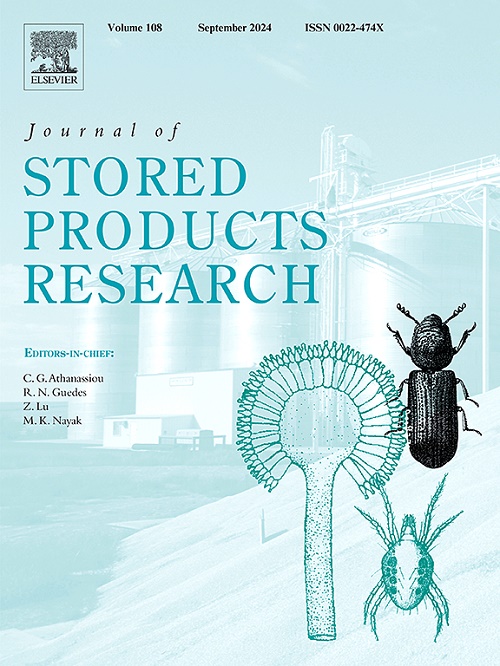The effect of modified atmospheres on the developmental stages of Sitotroga cerealella in stored wheat
IF 2.7
2区 农林科学
Q1 ENTOMOLOGY
引用次数: 0
Abstract
The efficacy of modified atmosphere with CO2 gas in three concentrations (20, 40 and 80%) for seven exposure times against different stages of Sitotroga cerealella were assessed. Mortality percent of life stages, adult emergence, F1 progeny, and chemical components in wheat grains were evaluated. The complete egg mortality (100 %) was achieved by 80% CO2 and exposure time (48 h) with LT50 value (2.5 h), 40 %CO2 and exposure time (96 h) with LT50 value (6.9 h) and 20% CO2 and exposure time (120 h) with LT50 value (18.8 h). The present study showed also, that larvae and pupae of S. cerealella were more tolerant than eggs. These two stages affected with increasing CO2 concentrations resulted reduction in adult emergence. Furthermore, the full mortality of adults was obtained by 20% CO2 after exposure time 96 h with LT50 value (26.9 h) and 40% CO2 after exposure time 72 h with LT50 value (12.8 h), respectively. The modified atmosphere affected progeny and reduced the adult emergence and the F1 generation more than half of resulted offspring from all life stages of S. cerealella. Also, the modified atmosphere caused slightly reduction in chemical components of wheat grains. These findings suggest that modified atmosphere may be a useful method for the management of this insect pest.
求助全文
约1分钟内获得全文
求助全文
来源期刊
CiteScore
5.70
自引率
18.50%
发文量
112
审稿时长
45 days
期刊介绍:
The Journal of Stored Products Research provides an international medium for the publication of both reviews and original results from laboratory and field studies on the preservation and safety of stored products, notably food stocks, covering storage-related problems from the producer through the supply chain to the consumer. Stored products are characterised by having relatively low moisture content and include raw and semi-processed foods, animal feedstuffs, and a range of other durable items, including materials such as clothing or museum artefacts.

 求助内容:
求助内容: 应助结果提醒方式:
应助结果提醒方式:


